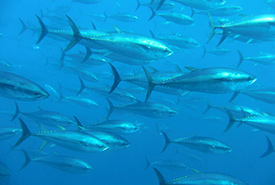
Atlantic bluefin tuna (Photo by Tom Pucher/iNaturalist)
Atlantic bluefin tuna
Unlike most fish, Atlantic bluefin tuna are warm blooded.
What does it look like?
These large marine fish are generally dark blue, with a lighter blue side and light grey underbelly. They have a streamlined (flatter) shape with a large dorsal fin on either side of its body. Adult fish can measure more than three metres in length and weigh over 700 kilograms.
Where does it live?
Atlantic bluefin tuna are highly migratory, meaning they travel frequently and far and, as a result, have a wide distribution range. This behaviour also means that they can tolerate a wide range of water conditions, including turbidity and temperature.
In summer, these fish are found in the waters of Atlantic Canada. In winter, they travel south to the Gulf of Mexico to spawn. However, new data from tagged fish indicates that they are also migrating west to east, from Canada to the Mediterranean Sea.
What does it eat?
Juvenile Atlantic bluefin tuna are opportunistic feeders; they eat whatever comes their way, including crustaceans, fish and cephalopods. Adult fish feed on herring, anchovy, mackerel and other bluefin.
Due to their long migratory route and constant swimming, Atlantic Bluefin tuna have a high metabolic rate and need to consume large amounts of prey to sustain themselves.
What is this species’ conservation status?
The Committee on the Status of Endangered Wildlife in Canada has listed Atlantic bluefin tuna as endangered. Globally, this species is also considered endangered by the International Union for Conservation of Nature.
Atlantic bluefin tuna, because of its large range, requires collaborative, multi-national cooperation for adequate population management and recovery.




